

Amphitheatre (early 1st century AD)


The Sanguinone Aqueduct, which brought water from Colle San Rufino to the city, also served the amphitheatre, which could be flooded for the re-enactment of naval battles. (This aqueduct was extended in 1238 to serve San Francesco, and surviving stretches of this extension are seen in Walk I.
Inscription Relating to the Amphitheatre
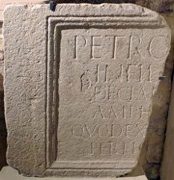
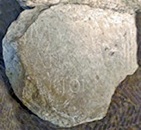
CIL XI 5406 CIL XI 5432
Two surviving fragmentary inscriptions that relate to the amphitheatre were found in nearby Piazza Matteotti and are in the Museo Civico:
-
✴A fragmentary inscription (CIL XI 5406) reads:
-
Petro .../ in fid.../ Decia.../ amphi.../ quod ex .../ perfic ...
-
✴A second fragmentary inscription (CIL XI 5432) reads:
-
[- - -]s municipi(- - -?)/ [- - - f]ratr(is) nomin(e)/ [- - - amphitea]tri ornam(ent-)
The EAGLE database (see the CIL links above) dates them to the 1st half of the 1st century AD. It reconstructs the first inscription as:
Petro[nia C(ai) f(ilia) Galeonis 〈:uxor〉]
in fid[eicommisso solvendo?]
Decian[i fratris nomine, ((sestertium)) - - - dedit in opus?]
amph[itheatri cum ornamentis?]
quod ex [testamento ex ((sestertium)) - - - fieri iussit?]
perfic[iendum curavit - - -].
Its reconstruction of the second suggests that this contained broadly the same information. In short, the original inscriptions probably recorded that Petronia, wife of Galeo, completed the construction and/or decoration of the amphitheatre as the executor of her brother, Caius Petronius Decianus.
Remains of the Amphitheatre
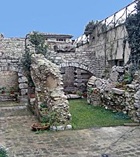
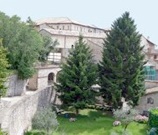
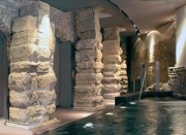
Part of the ex-nunnery of Santa Caterina is built on the foundations of an elliptical wall of the south-eastern part of amphitheatre. Excavations carried out in 2007 brought to light the remains of seven pilasters in the lower part of the facade; five are still standing but two seem to have collapsed during an earthquake. The convent now houses a hotel, and the excavated area now houses the hotel spa.
Baths (2nd century AD)
Roman remains found on the site of the nunnery of San Quirico were for a long time thought to relate to a temple, but they have recently been identified as those of the Roman baths.
Cistern (2nd century BC )
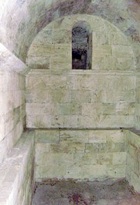
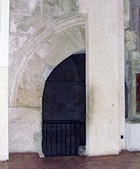

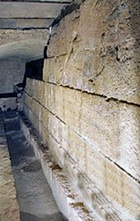
Domus at Palazzo Giampè (1st century BC)

The remains of this domus were discovered during restoration work on Palazzo Giampè in 2001. Three rooms have been excavated: the diaeta (sitting room), the triclinium (dining room) and a cubiculum (bedroom). The remains of a colonnaded garden include three columns and a black and white mosaic floor.
They all have superb frescoes in the so-called 3rd Pompeian style, which is that used at Pompeii in the period 20 BC-62 AD. These frescoes represent rare examples of the work of Roman artists in Umbria:
-
✴the north wall of the triclinium has frescoed architectural elements; and
-
✴there was a small painted tablet with a scene of a married couple on the north wall of the cubiculum, which is in the Museo Civico. Unfortunately, it was damaged during the restoration work, before it presence under the plaster had been detected. The floor of the cubiculum is is black and white mosaic laid out in a pattern of hexagons containing six-petaled flowers. surrounded by squares.
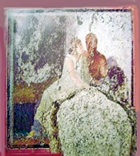
House of Propertius (1st century AD)

The remains of a rich Roman domus were discovered under Santa Maria Maggiore in 1864 and excavated more extensively in 1954. The excavated remains are accessed from the crypt of Santa Maria Maggiore.

-
“...on the basis of the surviving remains, it more probably belonged to [the poet Gaius Passennus Paullus Propertius Blaesus] rather than to his [more famous] ancestor” (my translation).
An inscription ((CIL XI 5405) on a funerary altar that commemorates this second poet survives in the Museo Civico.
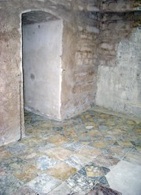
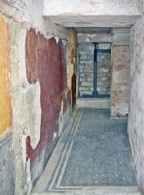
The domus contains three communicating rooms, two of which have mosaic floors and wall frescoes:
-
✴one of these rooms has a pavement made up of squares of coloured marble;
-
✴while the other has a black and white mosaic floor with marble inserts.
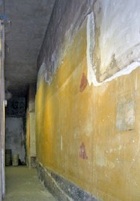
-
✴the myth of Janus, the son of Apollo; and
-
✴Apollo as the sun god, driving his chariot of fire across the sky.
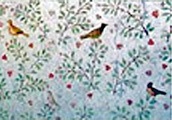

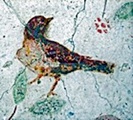
The niche on the right at the end of the cryptoporticus contains fine frescoes (ca. 70 AD) of plants and birds. These are in the so-called 4th Pompeian style, which is that used at Pompeii in the period 62-79 AD (the final period before the city was destroyed).
Some decorative elements that were recovered during the 1864 excavations are preserved in the Museo Civico.
Mausoleum (early 1st century AD)
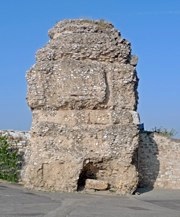
This two-storey brick mausoleum extends into the adjacent garden of San Rufino. Marble slabs that originally covered the surface of the mausoleum were removed in 1597 and used to construct Capuchins' convent at Sant' Antonio Abate. [Others at the corners of Palazzo Bovi ??]. Only the inner core and funerary chamber survive in situ.
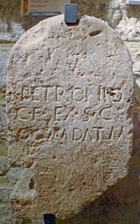
P(ublius) Petronio
C(ai) f(ilio) ex s(enatus) c(onsulto)
(l)ocum dat(u)m
This records that the municipal senate gave a site to Publius Petronius, son of Caius. The EAGLE database (see this CIL link) dates it to the 2nd half of the 1st century BC. It is possible that this inscription related to the mausoleum, although it seems to me that its dating precludes that.
However, it is possible that the senate gave a site in or near Piazza Matteotti to Publius Petronius for funerary purposes, and that CIL XI 5407 was his funerary monument. On this hypothesis, the mausoleum could have been built subsequently on this site for use by other members of the family. Another inscription (CIL XI 5409) in the Museo Civico (exhibit 32), which is from an unknown location in Assisi and which dates to the 3rd century AD, could support this hypothesis: although the surviving fragment reads only ‘SEPV’, an 18th century record of the inscription reads:
Petronio Umbro in loco publico sepulto ex decreto decurionum
Thus, Petronius Umber received permission for burial on public land some 3 centuries after a similar honour had been paid to Publius Petronius. It is possible that this land was around the site of the mausoleum. As Enrico Sciamanna (referenced below, at p. 142) reflected, if the person buried in the mausoleum did not belong to the gens Petronia, he:
-
“... must have belonged to an important family, on a par with or superior to that of the Petronii” (my translation).
Nymphaeum (ca. 100 BC)
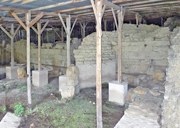
The remains of this monumental public fountain can be seen in the garden of Ristorante Paradiso, at Santureggio (just outside Assisi). The name of the location derives from the Latin "Sanctus et Regius Fons" (consecrated and royal fountain).
The remains comprise the rear wall and two smaller side walls of the Roman structure, which enclose a large paved basin. This basin collected the water from a natural spring that was channelled into a spout in a recess on the back wall. [Two leonine pronomes ?]
Various votive objects found here suggest that it was a cult site and that the waters were thought to be of therapeutic value. The spa probably remained in use until the middle of the 1st century AD.
Theatre (1st century AD)
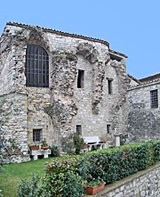
The ruins of three arcades in two registers in the garden of number 3, Via del Torrione seem to be part of a Roman theatre or circus.
Read more:
E. Sciamanna, “Asisium: Percorsi Archeologici nel più Importante Municipio Romano a Nord di Roma”, (2008) Assisi
G. Bonamente, “Properzio, un Esponente dell' Aristocrazia Municipale di Asisium nella Roma di Augusto”, in
C. Santini and F. Santucci (Eds.), “Properzio tra Storia, Arte, Mito: Atti del Convegno Internazionale, Assisi, 24-6 Maggio 2002”, (2004) Assisi
G. L. Gregori, “Amphitheatralia I”, Mélanges de l' École Française de Rome, 96 (1984) 961-85
Return to Monuments of Assisi.
Return to Walk I (Amphitheatre; Cistern; Mausoleum; and Theatre).
Return to Walk II (Palazzo Giampè; House of Propertius; and Nymphaeum).
Return to the home page on Assisi.

